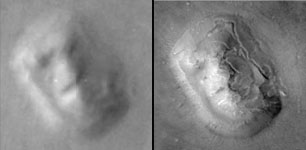
Lowell's Legacy- Part 4- Pareidolia and The Faces of Mars
"Startling as the outcome of these observations may appear at first, in truth there is nothing startling about it whatever. Such possibility has been quite on the cards ever since the existence of Mars itself was recognized by the Chaldean shepherds, or whoever the still more primeval astronomers may have been. Its strangeness is a purely subjective phenomenon, arising from the instinctive reluctance of man to admit the possibility of peers. Such would be comic were it not the inevitable consequence of the constitution of the universe. To be shy of anything resembling himself is part and parcel of man's own individuality. Like the savage who fears nothing so much as a strange man, like Crusoe who grows pale at the sight of footprints not his own, the civilized thinker instinctively turns from the thought of mind other than the one he himself knows. To admit into his conception of the cosmos other finite minds as factors has in it something of the weird. Any hypothesis to explain the facts, no matter how improbable or even palpably absurd it be, is better than this.
Snow-caps of solid carbonic acid gas, a planet cracked in a positively monomaniacal manner, meteors ploughing tracks across its surface with such mathematical precision that they must have been educated to the performance, and so forth and so on, in hypotheses each more astounding than its predecessor, commend themselves to man, if only by such means he may escape the admission of anything approaching his kind. Surely all this is puerile, and should as speedily as possible be outgrown. It is simply an instinct like any other, the projection of the instinct of self-preservation. We ought, therefore, to rise above it, and, where probability points to other things, boldly accept the fact provisionally, as we should the presence of oxygen, or iron, or anything else. Let us not cheat ourselves with words. Conservatism sounds finely, and covers any amount of ignorance and fear. We must be just as careful not to run to the other extreme, and draw deductions of purely local outgrowth.
To talk of Martian beings is not to mean Martian men. Just as the probabilities point to the one, so do they point away from the other. Even on this Earth man is of the nature of an accident. He is the survival of by no means the highest physical organism. He is not even a high form of mammal. Mind has been his making. For aught we can see, some lizard or batrachian might just as well have popped into his place early in the race, and been now the dominant creature of this Earth. Under different physical conditions, he would have been certain to do so. Amid the surroundings that exist on Mars, surroundings so different from our own, we may be practically sure other organisms have been evolved of which we have no cognizance. What manner of beings they may be we lack the data even to conceive."
-Percival Lowell
New data in the form of imaging may well have provided
the data that Lowell laments lacking. Like
our Cetacean glyphs, there are numerous examples of what appear to gigantic
human effigies found on Mars. While most likely not new to our readers, I feel
it is important to revisit the unusual images from our sister planet. The debate
over the artificiality of these objects will most likely rage until some graduate
students in archaeology and anthropology go there with shovels, possibly within
our lifetimes. Are these representations of human physiognomy on Mars or a trick
of light and shadow?
For an explanation of Pareidolia we quote from a recent paper on Martian anomalies:
"Over the past decade I have had the
opportunity to witness first hand the many peculiarities and somewhat duplicitous
behavior of our taxpayer supported governmental science agencies (NASA\JPL\
MSSS) in regards to any anomalies presented from outside the planetary science
community.
Offerings and contributions from earnest, hard working American citizens curious
about these issues and willing go the extra mile in bringing these anomalies
to the attention of our friends at NASA were either ignored, dismissed as „tricks
of light and shadowš or chalked up as pareidolia."
The skeptic‚s Dictionary (http://skepdic.com/pareidol.html) defines pareidolia As follows:
„ Pareidolia is a type of illusion or misperception involving a vague or obscure stimulus being perceived as something clear and distinct. For example, in the discolorations of a burnt tortilla one sees the face of Jesus Christ. Or one sees the image of Mother Theresa or Ronald Reagan in a cinnamon bun or the face of a man in the moon. Under ordinary circumstances, pareidolia provides a psychological explanation for many delusions based upon sense perception. For example, it explains many UFO sightings, as well as the hearing of sinister messages on records played backwards. Pareidolia explains Elvis, Bigfoot, and Loch Ness Monster sightings. It explains numerous religious apparitions and visions. And it explains why some people see a face or a building in a photograph of the Cydonia region of Mars.š
"So there you have it. Everyone from Giovanni Schiaparelli (19th century astronomer) to Richard C. Hoagland (21st century researcher) are all simply suffering from some mental aberration-most likely Freudian in Nature (probably some issue with their mothers!) that makes them able to see Jesus in a Tortilla chip. "
-Eric C. Lausch
Well, that certainly clears things
up!! All those dolphin images aren't really dolphins at all! They're just in
our imagination-like the man in the moon. Green cheese and all.
"in the last chapter we saw how badly off for water Mars, to all appearance, is; so badly off that inhabitants of that other world would have to irrigate to live. As to the actual presence there of such folk, the broad physical characteristics of the planet express no opinion beyond the silence of consent, but they have something very vital to say about the conditions under which alone their life could be led."
-Percival Lowell
And what of these images? Do they provide mute testimony "as to the actual presence there of such folk"? Is it simply our nature to be hard wired to see faces as the skeptics claim or are these "faces" something culturally significant that merits our full resources to study ? Are there monumental works of art littering the Martian deserts or is this pareidolia on a kilometers wide scale brought to us courtesy of the remote sensing gurus at JPL and MSSS? We believe Lowell would have agreed that these colossal edifices do provide a means to corroborate " the actual presence there of such folk" and a probable relationship between these unknown artisans and the many mysterious artifacts on Mars.
Below we see the greatly maligned Face on Mars at Cydonia Mensae from Viking Frame 70A13 side-by-side with a reduced-size version of a later MGS image of the Mars Face, E03-00824, acquired on April 8, 2001. The jury is still out on the Face. Litigation by FACETS forced NASA to re-image the Face and NASA/MSSS actually sat on the image for several months and released it to the public only after producing a full blown spin piece debunking it. Most of NASA's contentions about the Face have been challenged or refuted since anomalists have finally been allowed access to the spacecraft's ancillary data for the image.

The Face at
Cydonia Mensae
Image courtesy of Lan Fleming-VGL.org
The right side of the Cydonia face appears
slumped as if it were once a hollow structure that subsequently collapsed in
on itself. As a caveat to this we must mention that Richard C. Hoagland has
postulated in the early 1990's (prior to the acquistion of the MGS Cydonia images)
that the left side of the Cydonia Face is humanoid and the right side feline
in nature representing a hominid- feline hybrid of some sort. Further imaging
has borne out his conclusions. Whether by design or catastrophe, his analysis
is the most compelling yet. There are terrestrial archaeological finds that
set a precedent for such speculation. Many examples of these split faced gods
have been found in the digs of Mayan and Aztec ruins. A mirror image of the
right side of the Face is suggestive of a feline form.
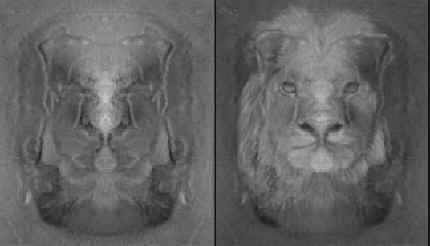
Mirror image of thr right side of the Cydonia Face compared to lion
Image courtesy of the Enterprise Mission
Mike Bara of The Enterprise Mission commented on these split faces on the Enterprise Mission website.
"So as we look to these ancient civilizations, we must question whether we see any similar examples in monumental architecture or cultural precedent to what we're now -- unmistakably -- seeing on Mars. It turns out that the Maya, one of the most advanced (if not in some ways the most mysterious) of these early "post-catastrophic civilizations," did indeed have exact examples of these "split faced gods" ..."there are indeed innumerable terrestrial examples of precisely such "split faces" among the Maya -- in ceremonial masks, monumental architecture, even in the classic "Mayan glyphs." In many cases, these split faces are precise man/animal hybrids (like the man/jaguar image, below) -- just as Hoagland long ago proposed for the Face on Mars."
-Mike Bara
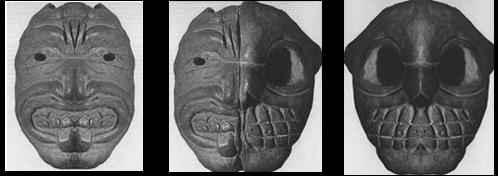
Original (middle), left symmetry (left)
and right symmetry (right)
http://www.enterprisemission.com/catbox.htm
Image courtesy of the Enterprise Mission
As for NASA's official position on the Face, the first official comments they made in regards it have been proven to be either woefully inaccurate or an outright lie. They would have that it is no more than a rocky mesa which somewhat resembles a human face. NASA has obfuscated on the existence of the Face since it's initial discovery and these recent attempts at debunkery after the FACETS re-imaging were not totally unexpected.
To quote from David Jink's seminal tome,"The Monkey and the Tetrahedron:
"The reasons for the Cydonia data's failure to rise above National Enquirer status are many. But one in particular has effectively banished the Face on Mars from the realm of accepted science: the space agency itself. Ironically, it is the administrators of NASA who have repeatedly blocked discussion of the Cydonia issue for well over 20 years. From the initial discovery of the Face to the present (at the time of this writing, October 1997), NASA's leaders have routinely attempted to deflect attention away from the controversial Face on Mars. The first press conference showcasing Viking images, for instance, solidified NASA official stance on the formation: it is not worthy of any consideration. Hoagland, who was a member of NASA's Pasadena-based Jet Propulsion Laboratory press corps covering the Viking mission at the time, recalled the July 20, 1976 meeting:
[Viking Project Scientist] Gerry Soffen
got up in front of us and showed us this quirky face and said, 'isn't it peculiar
what tricks of lighting and shadow can do.' And then he said, 'When we took
a picture a few hours later it all went away; it was just a trick, just the
way the light fell on it.'
Those of us who were there accepted this. The eerily face-like landform, NASA
assured the press more than two decades ago, was merely an illusion created
by fortuitous lighting of an average Martian mesa: The space agency had no interest
in examining the "face" further. Naturally, the press assumed that had there
been any chance the formation was a real artifact and not simply an eroded mountain,
NASA would have pursued it with ardor.
We now know that the Face had not undergone even a cursory analysis at that
point, and that the first real analysis of the Face-conducted soon thereafter
by DiPietro and Molenaar-revealed it to have strikingly artificial traits. It
is impossible, in fact, that a subsequent picture could have shown the Face
to be a trick of lighting, for any image taken "a few hours" after 35A72-captured
at approximately 6:00PM Local Time-would have been taken in complete darkness.
Thanks to Soffen's "trick of lighting and shadow" declaration, the Face immediately
disappeared from public view and NASA (and the rest of the world who had been
watching) filed it away as a fluke.
Was the NASA spokesman's statement simply the product of carelessness, or was
it an intentional deception? It is tempting to give him the benefit of the doubt-after
all, could we have expected the Face to be anything but an illusion? On the
other hand, Soffen said that a later image proved the landform to be a peculiarity
of the surface lighting, a claim easily shown to be false. Regardless of the
reason behind Soffen's initial remark-later characterized by the late popular
science icon Dr. Carl Sagan as "an unfortunate dismissal" -NASA's casual disregard
for the Face raised grave questions about the space agency's true motivations
in its self-proclaimed search for extraterrestrial life. (3)"
-David Jinks
When questioned as to the nature of the Cydonia face, Jinks gave this response:
" It is not clear. But the question
is one of artificiality, not of meaning. The "face" has a sufficient number
of anomalous properties to tilt the evidence in favor of artificiality, regardless
of what its artistic purposes are. Consider Mount Rushmore in a thousand or
10,000 years...would it be clear who or what it memorialized? Probably not.
But evidence of its carved nature would probably be evident. The case may be
the same for the "face." In my opinion, the strongest hypothesis regarding meaning
at this point is the dual hominid/feline symbolism espoused by Hoagland. I conclude
this because the facial detail is not symmetrical, but there appears to be a
horizontal eye, a broad nose bridge and a meandering, "muzzle" type mouth, consistent
with the leonine interpretation. However, based on the unusual "melted" appearance
of the "face's" east side, Van Flandern concludes that the east side has been
distorted severely. If this is true it might be impossible to know how it looked
originally. Only more images, preferably high-resolution color or thermal, will
reveal further artificiality. Things we might look for are supports, evidence
of tooling, or anomalous materials. We need more data than that NASA has been
willing to provide. Mars Odyssey should give us additional data, assuming NASA
keeps its promise, something the space agency has not been good at doing in
vis-a-vis the "face" mesa."
Another Viking era "Face"
was spotted near the border of Arabia Terra and the Syrtis Major regions. Eyes,
nose and lips are clearly recognizable. This image, like the Cydonia face, was
dismissed by NASA as pareidolia or a "trick of light and shadow".
Is this just another case of Martian pareidolia? Are we just imagining that
we see the sharply defined humanoid features in the crater's basin?
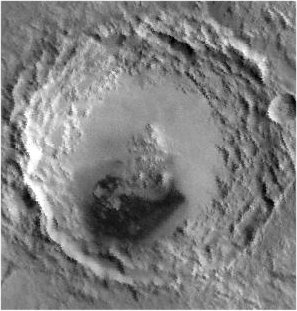
Viking - The "Face" at Arabia Terra
Viking Orbiter 1- Frame F369S07
Special thanks to Terry James
A comparative analysis seemed the next logical step in establishing the veracity of the "trick of light and shadow" position. An MOC wide angle image should be adequate enough for reasonable comparison. Searching the MGS archives revealed over a dozen narrow angle images have been taken of this general vicinity in Arabia Terra. Of these, all but three of them have MOC wide angle images.
Coincidentally, all of the missing wide angle images are the ones
that would have captured additional images of the Arabia Terra face.
Viking context image SP126004_GR
Image courtesy J. Danger
©2004 Dangerzone Productions
Each time the MGS acquires a target with narrow angle camera, under normal circumstances an accompanying wide angle context image of the area is automatically acquired. At least, that's standard operating procedure. This makes one wonder why these three particular images were singled out for different treatment than is the norm for MOC image acquisitions.
The MGS utilizes a Ground Data System or GDS. It controls what areas eventually get imaged.
The MOC Camera Overview describes GDS operation:
"Users of the Mars Observer Camera (MOC) will interact with the instrument through the MOC Ground Data System (GDS). The GDS is used to define observing programs for the MOC, schedule all the potential image acquisitions, construct uplink command sequences to carry them out, interpret the resulting instrument telemetry, and archive the returned image products for later processing."
The GDS controls MOC operations as follows. First, the user community defines a series of image acquisitions. The simplest such definition is a request to image a particular point on the planet with particular settings of the NA or WA cameras. This has been generalized to a particular area of the planet, a fraction of areal coverage, a range of emission angle, and a number of repetitions. For example, a user can tell the GDS to "take five 512x512 full-resolution WA images in two colors of any area between 130deg. and 140deg. west longitude and 10deg. N and 20deg. N latitude if the emission angle is <=10deg.." Given a collection of such specifications, the GDS examines the predicted ground track of the spacecraft over some planning interval (typically a week or two) and determines which observations can be made in that period. It then calculates the timing for all possible observations and checks to see if the instrument resources (power, buffer space, downlink data rate, and so on) can accommodate all the observations. If conflicts arise, observations with lower priority are thrown out or modified until the sequence is feasible. This conflict resolution can be done either automatically (by the application of simple rules) or interactively. Once a valid sequence is generated, it is converted into explicit MOC commands and uplinked to the instrument for execution. The GDS keeps track of all commanded acquisitions and informs the requestor when the image has been acquired and is available for examination in the MOC database.
-M. Caplinger
(source: http://www.msss.com/Mars/observer/camera/papers/gds_papers/GDS_overview/GDSoverview.html)
These paragraphs tell us that the MOC camera acquires images as combated by "the user". Some human at MSSS programs it to target certain areas. Some human at MSSS assigns which camera will be used and what imaging parameters are selected. Some human at MSSS assigns the imaging priorities. All this human intervention does make one curious as to why these areas were omitted from the wide angle imaging survey. After all, eventually they'd have to image the area for the global mapping subphase of the MGS mission.
About this time we'd expect Agent Scully to chime in and say,
"It's obvious Mulder, human error is the culprit."
Mulder of course would counter, "C'mon Scully...what are the chances of
a human or group of humans making the same random error three times in a row
on the same images on different orbits taken months apart?"
Another unusual incident related to this area can be found in the USGS MGS orbital archive. All images from a particular orbit are archived numerically in ascending order. The archive for MGS orbit M11-A starts with MOC image M1100001 continues through MOC image M1100520 listed sequentially. Every time a narrow angle image is acquired the next subsequent image in alphanumeric order is the wide angle context image for the preceding shot. For example, narrow angle image MOC M1100005 is followed by wide angle context image M1100006. The pattern is repeated throughout the image archives.
Of the 520 entries only one sequentially numbered image is missing the list, MOC image M1100087, the wide angle image for MOC image M1100086- the narrow angle strip taken just meters from the face at Arabia Terra. The face would have been smack dab in the middle of the context image - ripe for analysis.
The proof that wide angle image MOC M1100087 was acquired is the fact that it is missing from the database. If it was not taken, then the image that is numbered MOC 1100088 should have been recorded as the previous image number M1100087, with no apparent gap in the numbering. The wide angle image of the Arabia Terra face was acquired and subsequently omitted from the archive posting! If that's not a big enough oversight to raise eyebrows- the wide angle image is not displayed on the MSSS site with the narrow angle image as is the norm. Just another curious coincidence most likely.
Adding insult to injury, the USGS website lists this particular
sequence of MOC images out of order! This is the only error found in the numeric
sequence of 520 entries found the archive. The disordered entries appear as
if sloppily altered or perhaps intentionally marked by someone for later reference.
Another straw of circumstantial evidence to add to the proverbial camel's back.
USGS archive for MGS orbit M11-A
As for the reasoning behind such conspiratorial activity there is only one conclusion that can be drawn. The image showed something that "they" did not want to see. An immense effigy of a human face. What other logical reason could there be for the missing wide angle images, a dearth of mysterious circumstances and the sequestering of MOC image M1100087 along with the other missing context images for Arabia Terra?
Finally, one wide angle at low
resolution image was acquired for the mapping subphase of the MGS science
mission.
The MOC wide angle camera has a resolution about ten times lower than the Viking
imager. However, the lower resolution image does seem to support the contention
that this anomaly does indeed still look like a humanoid face staring up from
the surface of Mars.
The face at Arabia Terra
Image courtesy J. Danger
©2004 Dangerzone Productions
As the quality of the image used for comparison is so poor we
have decided to utilize an additional tool for analysis, Mars Laser Altimeter
data (MOLA) MGS uses a laser to measure elevations for use in producing detailed
topographical maps of Mars. An overlay of the image on MOLA data shows a sharp
rise in elevation at the face, indicating that it is a structure raised above
the surface of the crater.
MOLA data overlain on Arabia Terra Face
Special thanks to Robert Smith and John Levassuer
©2004 Dangerzone Productions
As for the narrow angle images
taken in Arabia Terra, MOC SP126004 reveals some interesting features in the
crater directly adjacent to the face. The distinctive banding of an immense
tunnel can be seen traversing the crater floor. Once again we find evidence
of the glass tunnel anomalies in concert with a large scale effigy or "landscape
art". A repeating class of objects on Mars. The area appears overrun with
dark undulating features that have a distinctly biological quality about them.
NASA has chosen to characterize these as "dark streaks overriding static
dunes". How original. To this author it appears to be more suggestive Momma
worm and a litter of pups than a sand dune.
Biological activity adjacent to tunnel ribs
.©2004 Dangerzone Productions
In April 2001, astronomer Tom Van Flandern's
Meta Research organization held a press conference at the National Press Club
showcasing numerous examples of large scale works of art and pictograms on the
surface of Mars. It received scant attention from the mainstream press and scathing
rebukes from the anomaly community, wondering if Mr. Van Flandern had lost his
senses. At the time, Mr. Van Flandern suggested that Mars was once an planetary
zoo or amusement park as one possible explanation for the statistically significant
incidence of effigies and intaglios on it's surface.
Van Flandern, a respected scientist and former head of the Celestial Mechanics
division of the U.S. Naval Observatory, had simply pointed out what his eyes
had shown him was obvious. Most folks don't deny seeing these shapes on Mars.
They simply cannot accept the possibility that this is a reasonable explanation
for these images based on what we've been taught about Mars. However, the more
data we collect on Mars the more we realize how little we really understand
about our closest planetary neighbor. This apparent giant carving a of crowned
head can easily be recognized as human physiognomy by the casual observer. Some
researchers have suggested other eroded carvings exist in the general vicinity.

The Martian Kingface MOC Image M0203051
Image courtesy of Dr. Tom Van Flandern
Is this pareidolia? A misperception involving a vague or obscure stimulus being perceived as something clear and distinct? Or is it something more? These puzzling anthropomorhic shapes are showing up in ever increasing numbers as we map the red planet. The obvious "interplanetary comparison" one can make is to the geoglyphs and monuments of the ancients.
Chisled into the side of a steep escarpment,
the Kingface appears severely weathered as if exposed to the elements for countless
eons. This unusual formation may be the result of fortuitous geologic faulting
and slumping of the cliff face. It is also possible that intelligent beings
utilized an existing natural formation which resembled a face and augmented
it to make it appear more human. The immense scale of the Martian effigies is
such that small detail would not be needed as they would have been meant to
be viewed from great distances.
The Martian Kingface
MOC Image M0203051
©2004 Dangerzone Productions
In the valley below the Kingface we see
the familiar rippled pattern of the riblike supports of the Martian tunnels
buried beneath the sand. Again and again we see large scale effigies or landscape
art in concert with this rippling pattern. While some may say these ripples
are simple dunes running the length of the valley further examination of MOC
image M0203051 reveals an additional partially exposed section of tunnel in
the area.
MOC Image M0203051
©2004 Dangerzone Productions
Closer inspection of this area reveals what we believe to be the
smaller"glass tunnels" which have imaged in numerous MGS images around
Mars. The glass tunnels radiate out from the larger canal, disappearing beneath
the surface of Mars. Again we see the "glass tunnels" in a geographically
adjacent area to a Martian effigy.
"Capillaries near the Kingface"
MOC Image M0203051
©2004 Dangerzone Productions
This Mt. Rushmore like edifice (below) towers over one-half mile above the northern lowlands of Mars like Crazy Horse above the Black Hills. This effigy, like the Cydonia Face, appears to be another example of the "split faced" gods similar to ones depicted in the Mayan ceremonial masks. The effigy contains elements of both human and fish and it has been suggested by Eric C. Lausch that this is a representation of the ancient Sumerian god "Oannes", who was half fish and half man and came from beneath the ocean to teach the Sumerians about science and mathematics. Predating the Egyptian cultures by two millennia, the Sumerians were the earliest recorded culture to utilize the written word (cunieform), design and build architectural wonders (ziggurats) and implement a system of laws and government.
Fronted by a slough of liquid water and backed by a steep escarpment, this would also seem to be an entrance to the "Glass Tunnels" of Mars. A nexus for these "tunnels" which appear to originate/terminate at it's location, as we illustrated in our annotated image strip, "A look at the Big Picture" which can be found at http://www.geocities.com/photon9999/bigpicture.htm .
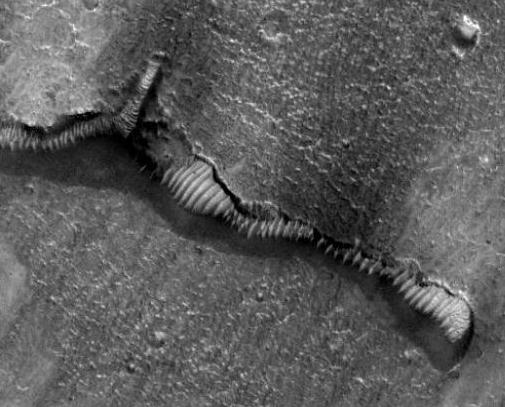
Oannes effigy at Acidalia Planitia
- Image courtesy of Bruce Magnotti - http://oannes.com
Johnny Danger's Grand Central Station MOC Image M1501228
An excellent article by Lausch which deals
with only hard facts and spacecraft ancillary data on this anomaly can be found
in an "Analysis of Imaging Data for Mars Global Surveyor Orbit M15-01228
- Is this an artificial construct on Mars?" which was featured in Viewzone
magazine.
The urls to the article are:
http://www.viewzone.com/Marsobject.html and http://www.geocities.com/photon9999/grandcentral.htm
.
At the time of the original article no MOLA
data was available for M15-01228. Almost three years later the data is finally
available. Your efficient use of tax dollars in action once again.
Image credit: Eric C. Lausch
©2004 Dangerzone Productions
Three dimensional shape from shading analysis
of this area clearly shows a series of tunnels branching out from this structure.
Analysis of imaging data reveals that the tunnels subsequently rendezvous with
large domes and unusual "craters".
Tunnels run beneath the surface from Grand
Central
Shape from shading courtesy of Chris Joseph
©2001 Chris Joseph & Dangerzone
Productions
Effigies and ancient tablets depicting Oannes
still survive today. If one was to wax "Von Daniken" an apparent similarity
to modern scuba gear might be made. The fish's head and gaping mouth (shown
in profile in the Sumerian plate) does look similar to a diving mask when pushed
to the top of ones head. The humps and scales on Oannes back could be some type
of breathing apparatus. The description of Oannes having "a mans feet within
his fish's tail" provokes images of divers removing their flippers.

Translation of Oannes tablet

Johnny Danger's Grand Central
Station with annotations
Images courtesy of Eric C. Lausch and Kevin Klettke
© 2001 Dangerzone productions
A comparison of George Washington at Mt.
Rushmore to the Oannes effigy at Acidalia Planitia at similar sun angles shows
both have the same patterns of shadows on the left side and around the eyes
and nose. As we can reliably state that Washington's head represents just that-a
giant head, it seems safe to assume that this analogous sculpture on Mars is
an artificial construct created to relay a similar cultural message. This is
not pareidolia.
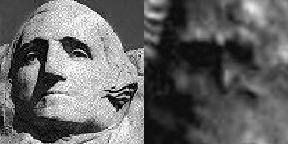
A comparison of George Washington
to Oannes
© 2001 Dangerzone productions
Scientists for Planetary SETI Research (SPSR)
member John Levassuer's "Nefertiri" face can be seen from two different
orbital image swaths. M0305549 was taken
July 28, 1999 at 13:36 Greenwich, E0501429 was taken June 15, 2001 at 23:40
Greenwich, both images were acquired at about 2:45 PM local time.
An excellent example of how compelling the Martian Rorschach test can become,
"Nefertiri" and her Egyptian style headdress can easily be discerned
from the surrounding terrain.
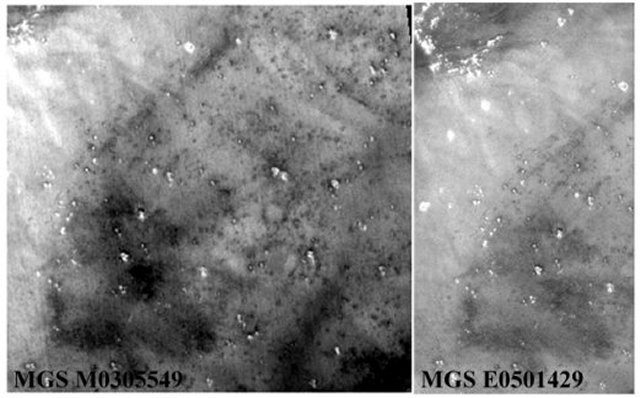
Nefertiri
Image credit: John Levassuer-SPSR
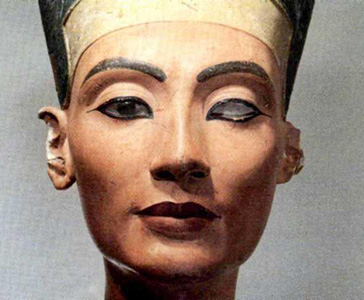
Bust of Nefertiri-Temple of Hathor
Special thanks to Dr. Joan Fletcher
Some quotes from Levassuer regarding this enormous pictogram on the surface of Mars
"They were taken about
ten and one half months apart. ...I figure the eye is about 110 meters across
between canthi (the points of the lid aperature). The hat is about 1300 meters
long. The face, vertically from chin to top of forehead, is about 670 meters.
*** is right when he says it would be very difficult to "draw" something
so well at this scale, even when using a fine surface grid as *** suggests.
In fact, I challenge anyone to draw the thing freehand with pencil and paper
any better. You can't do it unless you're a portrait artist. Even my tracings
don't do it justice."
"...***is right when he posts, "The reason that this image has received
scant attention is probably because it would be an example of 'flat art' and
I can't conceive of how we might test artificiality for "flat art"
objects."
"Although he is correct
that this is the prevailing view, I don't think it consists of any sort of "reason",
but more of an excuse. Indeed, the fact it is flat can be one of its strengths,
not a weakness. There's a looking-at-clouds mindset here that is very perverse
and a significant obstacle to a rational study of the formation."
"The shadows of the Cydonia Face were dismissed as tricks, so researchers
worked hard to show the object is indeed shaped the way it appears,
like a face. So researchers like *** had to prove the mountain is indeed shaped
like a face. This whole exercise was in the end, never a test
for artificiality, but only a response to the "trick of light and shadows"
contention, something completely unnecessary for the PI. There is no
such problem with the PI because there are no shadows. The E05 image proves
the colorations are in fact there on the surface and no fluke.
So my question is this: how exactly is this image more of a problem to test
for artificiality than ay other, full frontal, relief or not? Sure
it's flat, but why is it considered so different of a problem regarding artificiality
tests?"
-John Levassuer
"The effects of local intelligence...the
dearth of water......for if Nature chose she could afford there to build her
inhabitants on three times the scale
she does on Earth without their ever finding it out except by interplanetary
comparison."
Perhaps these unusual structures pictograms and intaglios are fair game for Lowell's interplanetary comparison. For a fellow who was derided for having an overactive imagination for 100 years it is entirely possible that Percival Lowell was more correct than he was incorrect! Lowell would have immediately recognized these vast works of art scattered across the surface of Mars as the remaining vestiges of a planetary society now fallen to ruins.
Lecturing to Europe and America
about a precursor to our own civilization, the descendants of which became the
mythical folk of Atlantis, Mu and Lemuria, whose further descendants spread
across the globe to influence the ancient civilizations of Earth. Expounding
on the ancients penchant for similar megalithic artifacts, traces of which can
still be found around the globe from Cern Abbas to Nazca to the Temples of Hathor
and Ramesses, Lowell would've been in his glory.

Temple of Ramesses
Special thanks to Zahi Hawass
Mac Tonnies' "Cydonian Imperative" newsletter recently reported on the Martian Geoglyph situation:
On page 24 of the Cydonian Imperative,
I published a brief paper called "The Out-of-Frame Hypothesis as Applied to
MGS Image #M0202619" by J.P. Levasseur, a member of the Society for Planetary
SETI Research (SPSR) . Levasseur, who maintains that some of the apparent profile
images seen on the Martian surface deserve serious scientific consideration,
arrived at his "out-of-frame" technique by noting the partial likeness of a
puma (or similar feline). Since the Mars Global Surveyor image showing the candidate
"puma" happened to terminate where the "tail" should be -- if the formation
was deliberately constructed to resemble a large cat -- Levasseur surmised that
future images showing the region of the hypothetical "tail" would help prove
or disprove his hunch that the "puma" was an intentional work of landscape art.
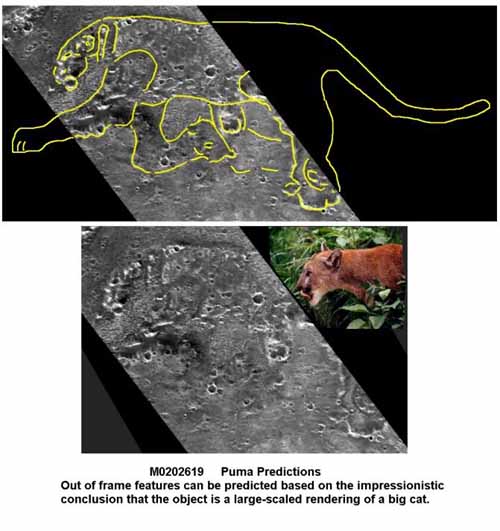
Levasseur's original prediction
Image Credit: John Levassuer
Fortunately, new images showing the area in question have arrived. And while disappointingly low-resolution, they appear to show a feature consistent with the "tail" predicted in Levasseur's original article. Levasseur's a priori out-of-frame method thus adds credibility to the idea that the "puma" may be more than random geomorphology. The discovery of the "tail"-like feature -- while certainly debatable -- challenges our criteria for potentially artificial Martian surface formations.
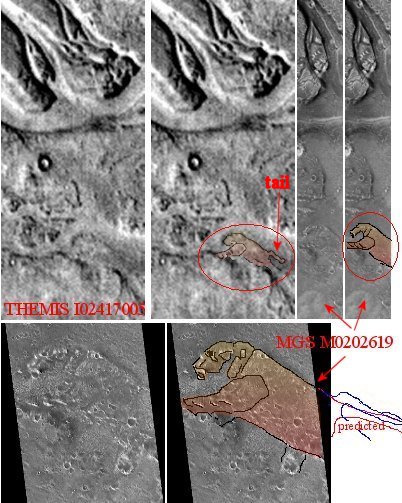
The "puma's tail" verified?
Image Credit: John Levassuer
Whereas most planetary SETI efforts involve analysis of upward-facing formations such as the Face and D&M Pyramid, asymmetric profiles tend to be brushed aside as fanciful "ink blots." (Mike Malin 's eager, and justified, dismissal of "Kermit the Frog" is a case in point.) While I personally sympathize with anomaly researchers who must incessantly contend with fragile claims of Nazca-like Martian "birds" and "seahorses," I am nevertheless intrigued by the argument behind Levasseur's technique, which is couched in scientific reasoning. This doesn't mean I endorse the "puma" as proof that a Martian civilization once used the planet's surface as a geological canvas. "Proof" of such isn't likely to manifest so conveniently. And it should be noted that some anomalists inclined toward the possibility of megalithic structures on Mars voiced dissatisfaction with Levasseur's original, tailless "puma" -- specifically, pointing out anatomical flaws such as an apparent "club foot."
I regard the out-of-frame method as an intellectual exercise that planetary SETI must deal with in its pursuit of hard evidence of intelligent extraterrestrial design. The out-of-frame technique's ability to isolate moments of genuine anomaly is largely untested because partially perceived likenesses simply aren't liable to come under scrutiny; familiar-looking shapes tend to catch the eye because they're generally intact, leaving out-of-frame prediction useless. To my knowledge, the "puma" is a lone exception. Regardless, Levasseur's unique approach is liable to ignite the philosophical foundations of the planetary SETI inquiry.
-Mac Tonnies
Coincidentally, one can find the familiar ripple pattern of the tunnel support ribs in the area of the flow channels seen just above Levassuer's Puma.
William of Occam (of Occam's Razors
fame) would tell us that the simplest explanation is usually correct.
Could we be looking at an explanation as simple as this on the surface of Mars?
We fully avow the existence of such mysterious intaglios on our own planet.
Why is this then such an tremendous leap of faith with regards to our nearest
planetary neighbor? Intelligent life may well have arisen on Mars long before
it did on Earth.
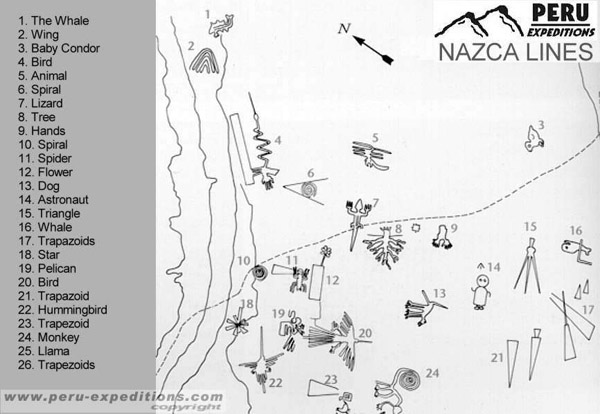
Image Courtesy of Peru Expeditions
No one will argue that there are
enormous works of art scattered across the Nazca plateau. We don't know who
made them or what their motivation was.
While we allow for this reality in regards
to terrestrial artifacts like Nazca, planetary scientists for the most part,
refuse to accept this possibility on the surface of Mars. Needless to say they
are both the remnants of a civilization that disappeared before our recorded
history began.
Perhaps Mars was Atlantis, an island in the sea of space rather an island upon
the ocean of Earth.
Most planetary scientists (and
many others) would hesitate to make this leap of faith even when they can see
it with their own eyes. A rendering of a whale high in the arid mountains of
Peru really isn't much more likely than whale carvings on the surface of Mars.
Both would seem highly unlikely to conventional wisdom. Perhaps convention should
be cast aside in light of new data acquisitions.
On a hillside near Nazca we see
what is commonly known as the "Parrot Geoglyph", albeit a stylized
rendering, most anthropologists would agree on this point.
One would make note that this parrot is not anatomically correct and that it's
toes all point in the same direction, but most folks agree that this is an intelligently
designed intaglio created to represent some type of avian creature, most likely
a parrot.
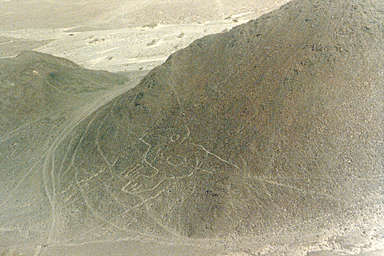
The parrot Glyph at Nazca
Image courtesy of parrots whose toes all point the same direction
Here's a recent e-mail exchange from an Mars anomaly BBS on how some members of the anomaly community would treat a similar parrot geoglyph found on Mars:
"Let's say you have what
seems to be a geoglyph of a giant parrot on Mars, and not just a amateur web
surfer but a real live veterinarian certifies that their professional knowledge
deems it to be not just any generic birdy but a parrot, by golly.
Heretic anomalist looks up parrot anatomy on web, finds out that distinguishing
feature of parrot family is that they have zygodactyl feet, meaning toes pointing
both fore and aft for better gripping of branches. Looks at alleged geoglyph,
with toes outlined all pointing in same direction. Feet say this is not a parrot.
When this is pointed out, anomalist adroitly thanks for correction, says the
picture was not outlined correctly, sidestepping the rather important issue
that the veterinarian neglected to note this important detail at the time.
If you are going to say that something you see is a parrot, order Psittaciformes, you had better be able to say exactly why it is not a member of the order Pelecaniformes, to which the blue-footed booby belongs. If you want to just say it is a cute little birdy, that's fine, but if you go any further in taxonomy you had better be able to support your claim with facts more substantial than "But this is a MARTIAN birdy, that's why it is different." If there are discrepancies, and you get caught afterward and have to make up something fast, it looks like you don't actually know what you are talking about. So that is why you need to have your Anseriformes all in a row before making claims you might not be able to support.
-Name withheld to protect the guilty party
This is an excellent insight into how certain individuals in the anomaly and planetary science communities will nit pick endlessly and go to great lengths to debunk any researchers delving into this particular area of Mars anomaly research, attacking such proposals with a vehemence unseen since the McCarthy era. And yet some of these same individuals will support the notion of a great carven face at Cydonia. The logic behind such duplicitousness escapes us.
Perhaps this writer should contact UNESCO and let the antiquities folks know that the Nazca parrot geoglyph does not live up to the scrutiny of the Mars anomaly community as it's toes are all wrong and it is anatomically flawed. By the respondents standards, this geoglyph at Nazca does not qualify for artificiality using the same standards which they've applied to a similar phenomena on Mars. It automatically has instant credibility problems (as do its proponents) when judged by the same criteria as the Martian glyphs, even though most Nazca savvy anthropologists would agree this does indeed represent a parrot.
What species of parrot or bird it represents is hardly an issue. And most likely Martian Birdies would exhibit some differences from their terrestrial ilk when applying Lowell's "interplanetary comparison". However, we can definitely state that it is definitely not attributable to pareidolia. It exists and was created to signify some cultural significance to ancient man. It is not unreasonable to assume the same for the Martian geoglyphs. Our knowledge of ancient terrestrial societies was garnered chiefly from studying similar ancient artifacts and the same process of observation and hypothesis should apply to the Martian geoglyphs. Scientific method is not malleable on a case by case basis and those utilizing such double standards should be heartily discouraged.
This growing "class of similar objects" on Mars is highly provocative and evokes passionate disagreements between researchers. Never the less, as multiple images of these works of Martian surface art confirm, this phenomenon is real and should be pursued with scientific zeal as a part of our continuing studies of Mars. If mainstream science views carved effigies and geoglyphs as a "class" of objects indicative of former high civilizations here on Earth, why then are they not indicative of the same thing when they are discovered on Mars? Most likely because we were taught in science class that Mars was a dead planet. Now only a few years into a comprehensive ongoing mission to map Mars and it's potential resources are we beginning to find what we were taught in school is suspect in light of knew knowledge. We know now that Mars could easily have harbored life for a extended geological period. Therefore it is entirely possible that these geoglyphs are the product of civilization.
"From the orbits of the heavenly bodies to phyllotaxis and human features, this diversity in uniformity is apparent. As a rule, the divergences, though small, are quite perceptible; that is, the lack of absolute uniformity is comparable to the uniformity itself, and not of the negligible second order of unimportance. In fact, it is by the very presence of uniformity and precision that we suspect things of artificiality. It was the mathematical shape of the Ohio mounds that suggested mound-builders; and so with the thousand objects of every-day life. Too great regularity is in itself the most suspicious of circumstances that some finite intelligence has been at work."
-Percival Lowell
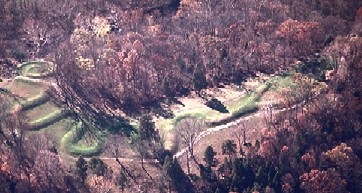
Image Courtesy Ohio State Park System
Seen from high above the rolling
farmlands of Adams County, Ohio no one disputes that there is an prehistoric
effigy of a giant snake about 1300 feet long, whose coils are perfectly aligned
with the solstices and equinox sunrise, while the egg in it's mouth points directly
towards the summer solstice sunset. At one time the a large portion of the United
States sported as many as 10,000 large effigy mounds built by the Hopewell,
Adena and Missisipian cultures, which for the most part have succumbed to the
ravages of time and the farmer's plow. Millions of people live near them without
knowing of their existence as they have become unrecognizable. This, however
does not preclude their existence and as Lowell exhorted it probably increases
the chance of these being culturally significant artifacts.
Why then, upon seeing similar phenomena on Mars, does the Planetary Science
community dismisses these unusual morphologies out of hand as faces in the sands
or a trick of light and shadow? Such effigies are dismissed as pareidolia without
even a cursory examination of the data to determine whether or not it should
merit further attention. Perhaps someday this mindset will become passé'
and anthropologists will publish white papers on the effigies of Mars.
The "Alligator Mound", a Hopewell
effigy near the village of Granville, Ohio was studied in great detail by various
researchers in the19th century. Unfortunately it has suffered considerably from
erosion due to decades of cultivation and the grazing of livestock (as have
most of the Midwestern earthworks). Today is is part of a landscape design for
an upscale housing development.
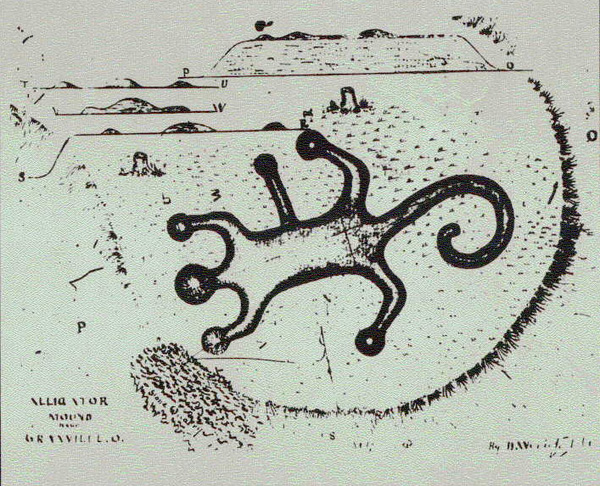
The Alligator Mound-David Wyrick (1837)
Shown below is what Keith Laney calls (his
tongue planted firmly in cheek) the Hellasgator, in reference to the Hellas
basin area on Mars in which it was found. Comparison to David Wyrick's 1837
illustration of the Alligator mound yields a eerie comparison, slumping into
oblivion over the ages. Is this pareidolia? Or the Martian equivalent of what
Wyrick sketched so many years ago? The hopeful, inquisitive scientists of the
nineteenth century would readily accept such a contention. The stodgy, unimaginative
science of Carl Sagan has numerous problems with such common sense observations.
In the end, only a trip to Mars can answer this question decisively. To dismiss
such images without any real investigation is an intellectual travesty and an
egregious waste of taxpayer funding.
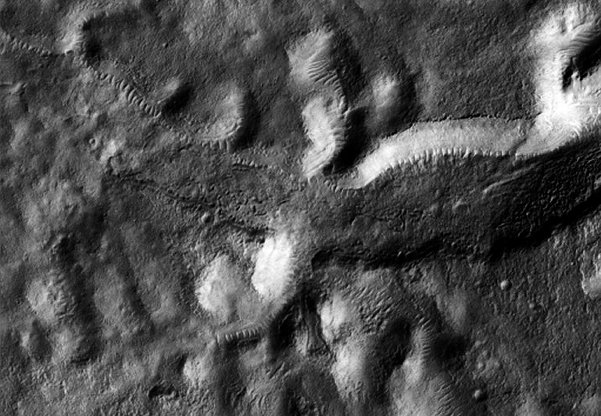
The Hellasgator
Image courtesy of Keith Laney
Again we see a series of parallel crennelations, indicative of the support ribs characteristic of the Martian "glass tunnel" phenomenon, that appear to converge upon and run the length of the Hellasgator. Once again we are confronted with repeating sets of tunnels and effigies on the surface of Mars. How can such repetition be dismissed as pareidolia? Laney's gator, like Levassuers' puma geoglyph, is truncated in the image strip. As Levassuer suggests, viewing the adjacent image strips (if there are any) may well provide a better context for interpreting this image which is so reminiscent of the mounds built by the Ft. Ancient people of early America. It may merely be a flow channel that by happenstance resembles an alligator. Percival Lowell might well have envisioned a habitat for supporting a population of Martian Mega-Crocs whom had been deified in effigy with a wading pond shaped in their likeness, laying about sunning themselves on a warm Martian afternoon.
Giant eroded lizard effigies in the cornfields of Ohio we believe quite readily. Similar effigies found on Mars, which like the glyphs at Nazca, are best viewed from above, are apparently much harder to ascribe to artificial design and origin by planetary scientists. Our only knowledge of the mound building cultures is from studying ancient artifacts, chiefly the few remaining earthworks and it's accompanying archaeological cache. Much of the research was done long ago and the sites that were studied in detail 150 years ago are themselves so badly eroded as to not be recognizable after the ingress of modern civilization and the ravages of the weather and modern agriculture. Few of them survive outside of the state park systems in Ohio and Wisconsin.
Perhaps the Gitchie Manitou is alive and
well and living on Mars.
Like the Midwestern earthworks or the Sphinx at Giza, we may only come to study
the artifacts of Mars in earnest once there is an extended human presence on
Mars to determine if there's more to this than meets the eye. The Sphinx itself
would have succumb to the elements long ago if not for numerous repairs and
excavations that were begun in the time of the Pharaohs and continue today.
Any artifacts on Mars would most likely also suffer from similar degradation,
the exception being the "Oannes" effigy at "Grand Central"
which appears to be in remarkably good repair when compared to other sites.
It is not so difficult to envision the crumbling
necropolis of Mars when we apply Lowell's "interplanetary comparison".

The Sphinx at Giza
"Were Mars like the Earth, we might well despair of detecting signs of any Martians for some time yet. Across the gulf of space that separates us from Mars, an area thirty miles wide would just be perceptible as a dot. It would, in such case, be hopeless to look for evidence of folk. Anything like London or New, York, or even Chicago in its own estimation would be too small to be seen, so sorry a figure does man cut upon the Earth he thinks to own."
-Percival Lowell
Lowell was correct in his assumption that it would take some time before sufficient data was acquired to pursue the artificiality hypothesis. Almost ninety years after his death we still look for answers to questions Lowell raised long before our births.
In part five we discuss MOC image strip E0400863, yet another image strip from the Acidalia region which shows an intact section of Lowell's Canals (the "Glass Tunnels") that seems to contains all the "classes" of objects discussed in this piece.